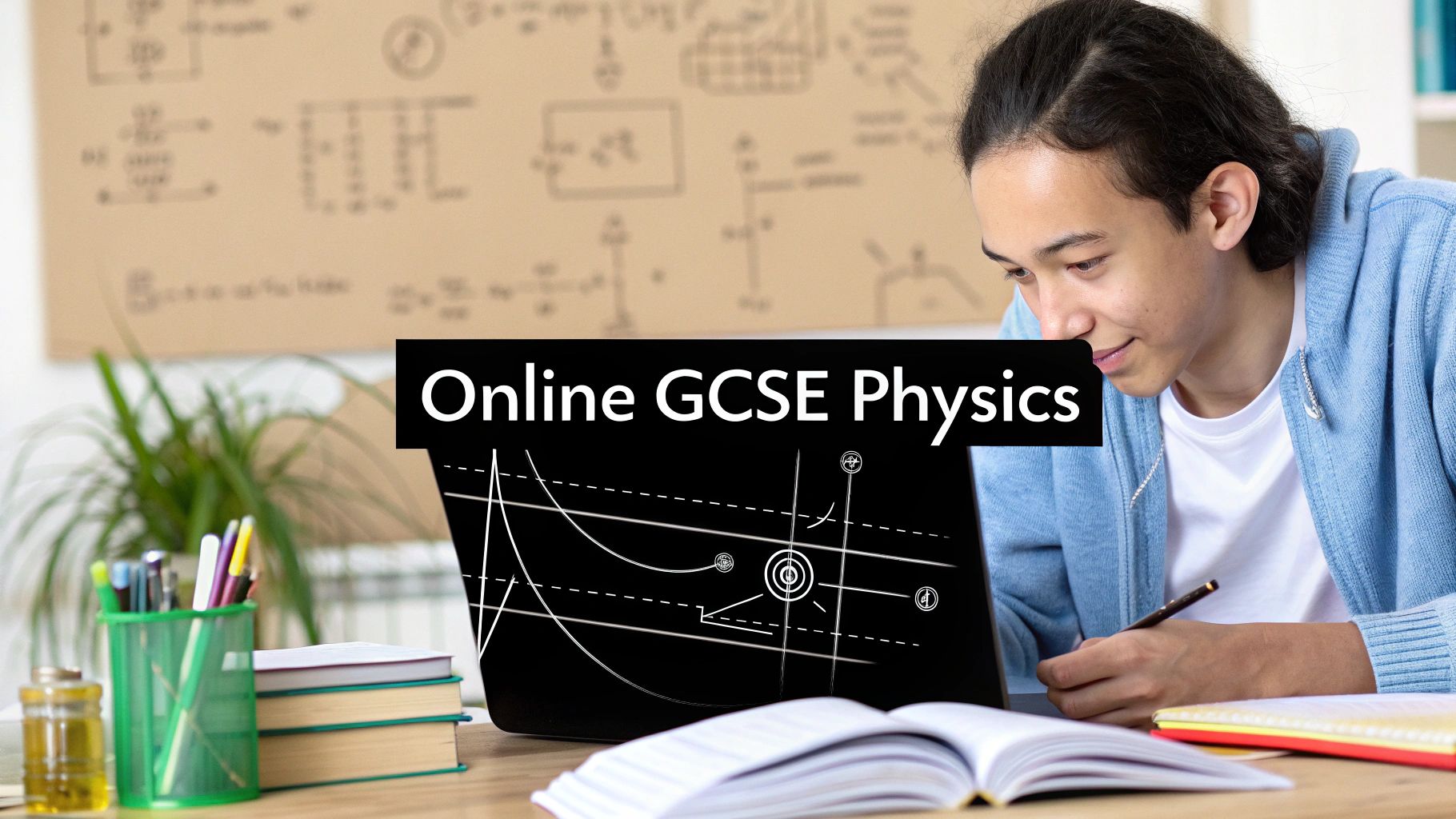Watching your child struggle with physics can be heart-wrenching. The abstract ideas and tricky maths can feel overwhelming in a busy classroom, leaving them feeling lost and left behind. An online GCSE Physics course offers a completely different approach—one that’s flexible, supportive, and lets your child learn at their own speed. It's about finding an environment where their confidence can blossom and they can truly succeed.
Is Online GCSE Physics Right For Your Child?
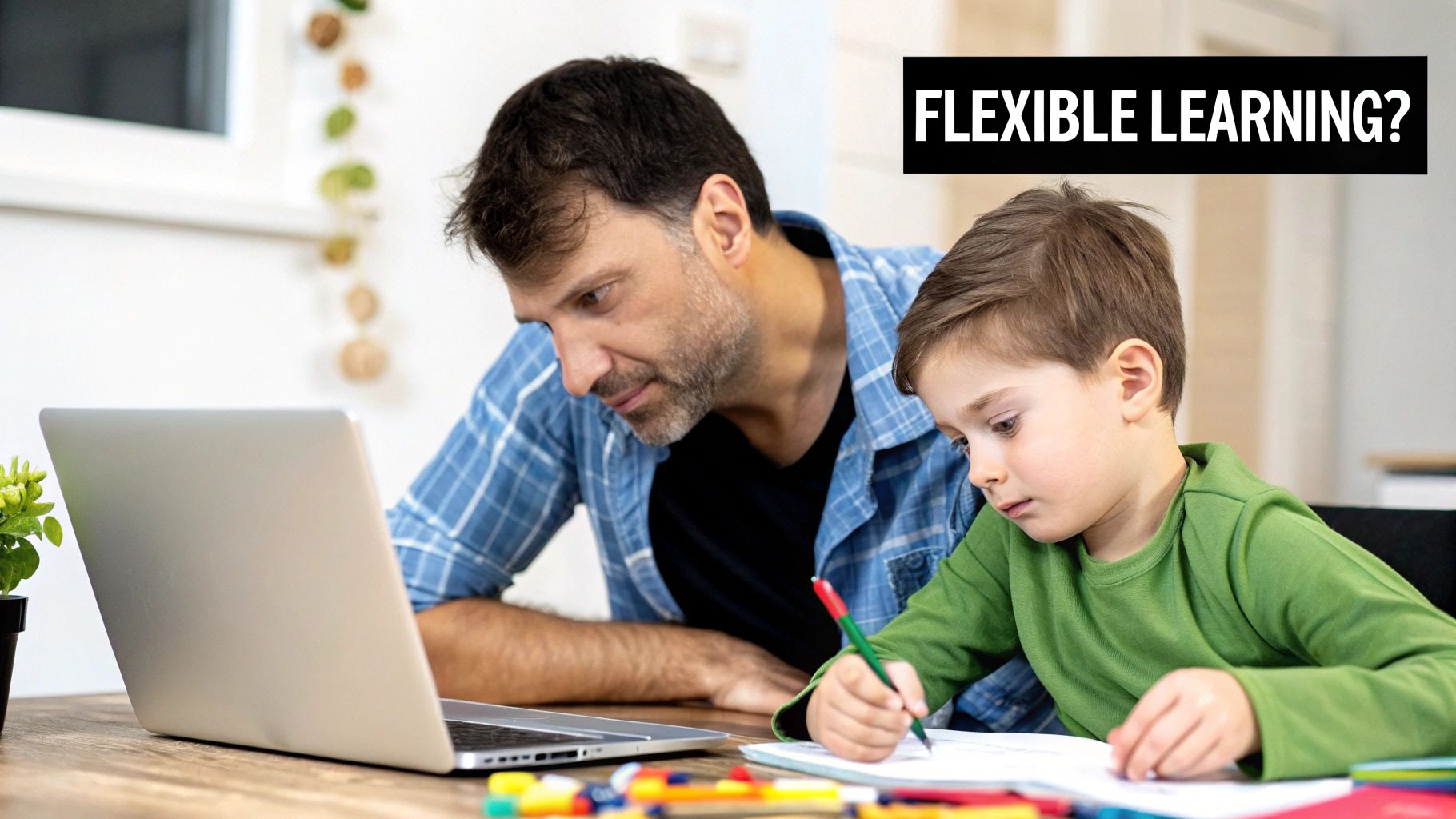
It’s one of the hardest things for a parent to see: that natural curiosity your child once had about the world slowly turning into frustration. Physics, with its complex theories and numbers, can often feel like an impossible puzzle. You know they have the potential, but the rigid pace of a traditional school just isn’t giving them the space they need to connect the dots.
That feeling of worry is completely understandable. You’re not just looking for a quick fix; you’re searching for a solution that puts your child’s confidence and well-being first. This is where looking into an online GCSE Physics course becomes more than just an option—it’s a proactive step towards finding a place where they can finally thrive.
Recognising The Signs
So, how do you know if an online course is the right move for your family? The signs are often clearer than you think. Your child might flourish in an online setting if they:
- Need More Time to Think: They grasp the concepts but need a moment for everything to sink in. Online lessons let them pause an explanation of electrical circuits or rewatch a video on Newton's Laws as many times as they need, without any pressure.
- Learn Best in the Quiet: For some students, the constant noise and social buzz of a classroom are just too distracting. A calm, focused space at home lets them concentrate on the material without interruption.
- Have a Unique Learning Style: Maybe they’re a visual learner who would benefit from animated diagrams of forces, or a hands-on learner who’d love interactive simulations. Imagine them building a virtual circuit instead of just reading about one; online learning is packed with tools to suit how they learn best.
For many students, the ability to learn at their own pace is the single most important factor in rebuilding their academic confidence. It transforms learning from a race into a personal journey of discovery.
This isn't about running away from a challenge; it's about giving them the right tools to face it. When a child can control the speed of their learning, they take back ownership of their education. For example, if they're stuck on the idea of energy transfer, they can spend a whole afternoon on just that topic, using virtual labs to see it in action and practice questions until it finally clicks. That's a level of personalised attention a teacher with 30 students simply can't offer.
Before you make a decision, it helps to see the differences side-by-side.
Traditional vs Online Physics: A Quick Comparison
Here’s a quick breakdown of how the two environments stack up from your child's point of view.
| Feature | Traditional Classroom | Online Learning Environment |
|---|---|---|
| Pacing | The whole class moves at the teacher's speed. | Students set their own pace, re-watching lessons as needed. |
| Support | Questions are asked in front of everyone, which can be daunting. | Direct, private access to teachers for one-on-one help. |
| Environment | Can be noisy and full of social distractions. | A quiet, focused setting tailored to the student. |
| Learning Tools | Mostly reliant on textbooks and whiteboards. | A mix of videos, interactive simulations, and digital resources. |
| Confidence Building | Easy to feel "behind" or compared to peers. | Focus is on personal progress, not competition. |
| Flexibility | Fixed timetable, meaning less time for tricky subjects. | Students can dedicate more time to topics they find challenging. |
Ultimately, choosing an online course is about empathy. It’s understanding that every child’s path is different. With resources like the science GCSE online course materials at Queen’s Online School, you're not just finding a new way to learn physics—you're giving your child a chance to rediscover their love for it.
What an Online GCSE Physics Course Really Looks Like
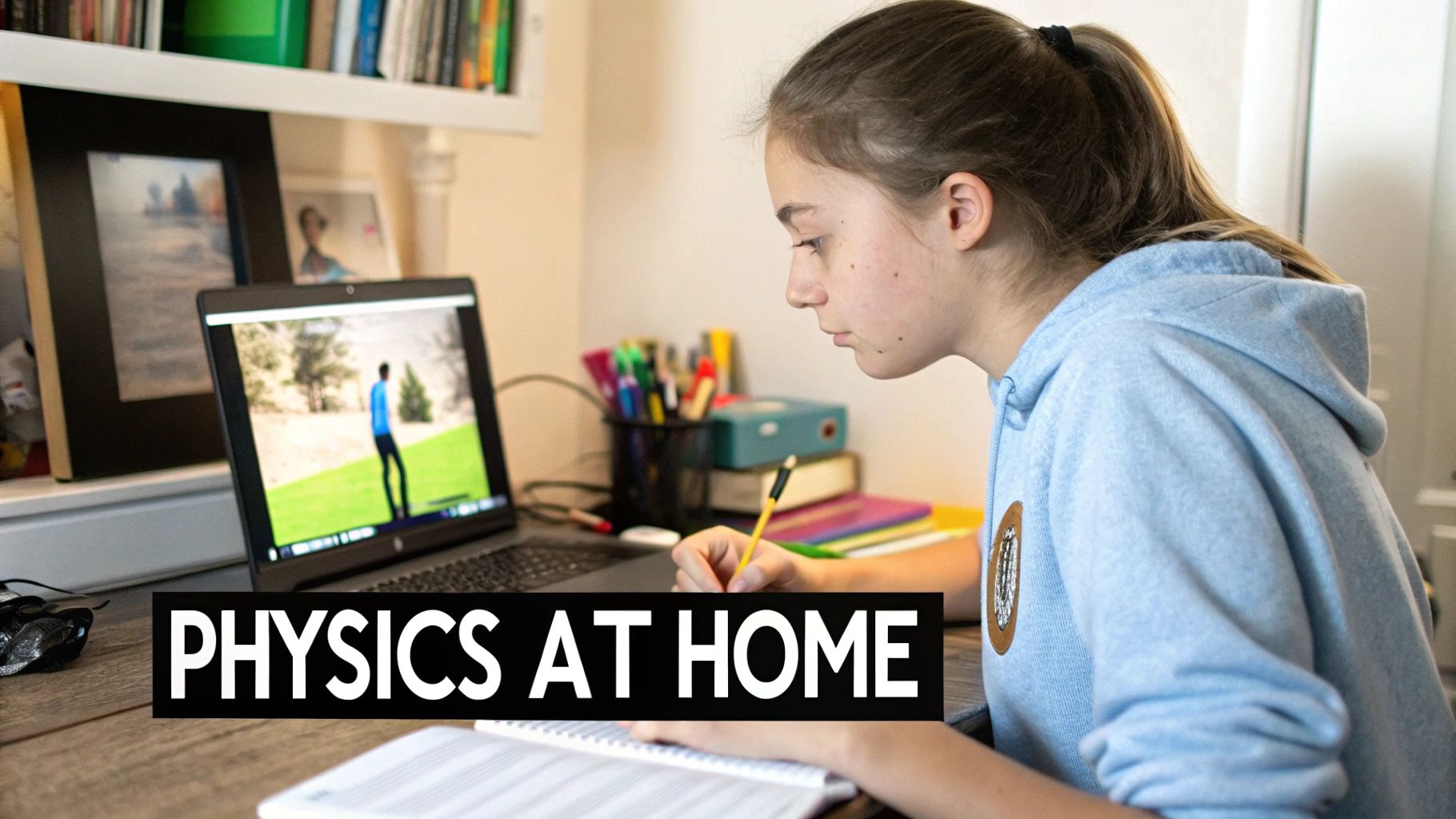
The phrase "online GCSE Physics course" can sound a little vague. What does it actually mean for your child on a typical Tuesday afternoon? I can tell you it’s a world away from just reading a textbook on a screen. Think of it as a dynamic, responsive learning environment, built from the ground up to make physics click.
Let's imagine your child hits a wall trying to get their head around momentum. In a busy classroom, the lesson would simply move on, leaving them feeling lost and discouraged. At home, though, it’s a different story. They can pause the video lesson, rewind, and rewatch the explanation of a car braking as many times as they need until it finally starts to make sense.
That level of control is the first big shift. It gets rid of the fear of "falling behind" and gives them a genuine sense of ownership over their own learning.
A Classroom Built for Curiosity
The online classroom isn't just one thing; it's a whole ecosystem of tools designed to build understanding, piece by piece. It brings together different resources that speak to different ways of thinking, turning abstract ideas into something your child can actually get to grips with.
A typical lesson might blend several elements:
- Dynamic Video Tutorials: These aren't your standard, dry lectures. They are engaging, often animated, videos that show you exactly how forces interact in a tug-of-war or how energy is transferred when a ball is thrown, breaking down big topics into small, digestible chunks.
- Interactive Simulations: What's the best way to understand how changing the voltage in a circuit affects the current? By building a virtual one yourself. Your child can experiment safely, tweak variables, and see the results instantly, making connections that will stick.
- Instant Feedback Quizzes: After a lesson, they can quickly test what they’ve learned with a short quiz. Getting immediate feedback—whether they’re right or wrong—cements the information and flags exactly where they need to focus. It’s a methodical way to build confidence, one question at a time.
This blended approach makes learning an active process, not a passive one. Your child isn’t just absorbing information; they’re interacting with it, experimenting, and applying what they've learned in the moment.
Personalised Support and Pacing
One of the biggest worries for any parent is that their child will get lost in the material without a teacher right there in the room. But a well-designed online GCSE Physics course is structured to provide targeted, easy-to-access support that respects every child's individual pace.
Think about a tricky topic like electromagnetism. If your child gets stuck, they don't have to wait with their hand up in a class of 30. They can fire off a direct message to their tutor with their specific question and get a detailed, one-on-one explanation back.
An online course transforms learning from a public performance into a private conversation. This safety allows students to ask the "silly" questions they'd otherwise keep to themselves, which are often the keys to unlocking real understanding.
This flexibility allows students to learn at a speed that works for them, which is a massive advantage for independent learners. Being able to go back over complex topics whenever they need to makes online learning a powerful route to achieving high grades.
The Technology Behind the Learning
The online learning space is always improving, with fascinating AI in education examples showing how technology is shaping the student experience. These developments have a direct impact on what an online course can do, from adaptive quizzes that change based on your child's skill level to intelligent revision planners.
Picking the right provider is key to making sure your child has access to these powerful tools. It’s well worth exploring some of the best online learning platforms to compare how they structure their courses and support their students. Once you understand what a day in the life of an online learner really looks like, you’ll see that this model doesn’t just copy the classroom—it improves it, creating a supportive, engaging, and genuinely effective educational journey for your child.
Navigating The GCSE Physics Curriculum From Home
The official GCSE Physics syllabus can feel like a long, intimidating list of complicated terms. For a child already feeling a bit overwhelmed, it can look like a mountain they’ll never be able to climb. But what if that mountain was actually just a series of small, connected hills?
The secret to mastering an online GCSE Physics course is realising that every big, scary topic is built from simple ideas your child already understands from their everyday life. Our job as parents and educators is to be the trail guide, showing them the familiar paths that lead to real understanding.
When we connect abstract concepts like energy transfer or forces to tangible, real-world examples, the fear melts away. It’s replaced by a spark of curiosity and that brilliant "Oh, I get this!" moment. Suddenly, the curriculum isn't a list to be memorised; it becomes a new way of seeing the world through their eyes.
The whole subject is structured around a few core pillars. This diagram shows how it all breaks down into key areas like Energy, Forces, and Electricity.
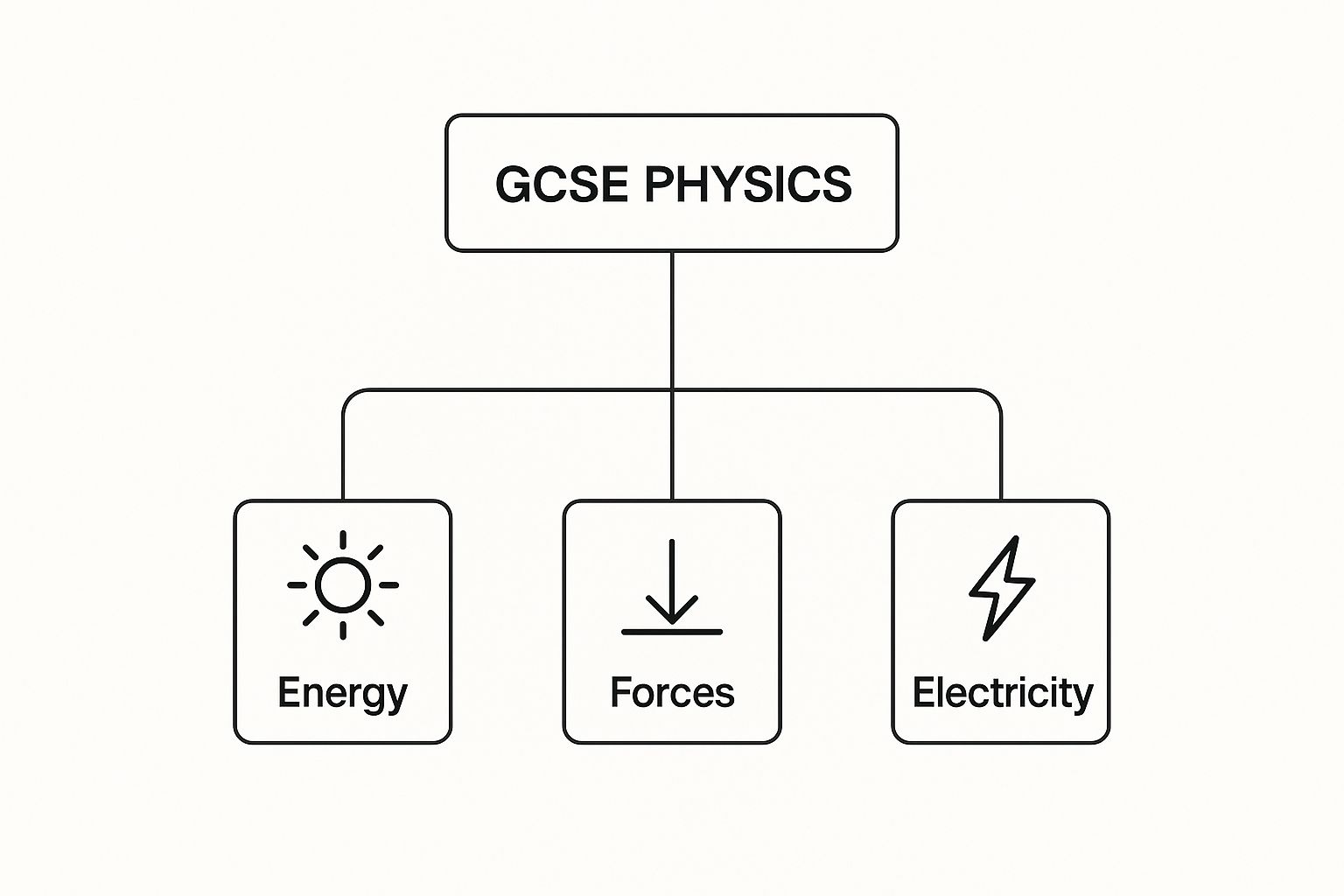
This structure really helps to demystify the subject. It shows that physics isn’t an endless list of disconnected facts but a few central themes that explain how absolutely everything works.
To make this even clearer, we've broken down some core topics and connected them to things your child definitely knows.
Core GCSE Physics Topics With Everyday Examples
| Curriculum Topic | Core Concept | Real-World Example Your Child Knows |
|---|---|---|
| Energy | Energy is transferred, stored, and conserved, but never created or destroyed. | Making a cup of tea: Electrical energy from the wall becomes thermal energy in the kettle's element, which heats the water. |
| Forces & Motion | Forces like gravity, friction, and air resistance affect how objects move. | Riding a bike: They push the pedals (force) to move, but friction and air resistance try to slow them down. |
| Waves | Waves transfer energy without transferring matter. Their properties (frequency, amplitude) determine what we see and hear. | Listening to music: Sound travels in waves from the speaker to their ears. Higher pitch means a higher frequency. |
| Electricity | An electric current is a flow of charge, which needs a complete circuit to travel around. | Charging their phone: A circuit is completed, allowing electricity to flow from the plug, through the charger, to the phone's battery. |
| Magnetism & Electromagnetism | Moving charges create magnetic fields, and changing magnetic fields create electric currents. | Electric motors in toys: A simple motor uses electricity and magnets to create the spinning motion that makes a toy car move. |
| Particle Model of Matter | All substances are made of particles, and their arrangement and movement determine if it's a solid, liquid, or gas. | Ice melting in a drink: The solid ice (tightly packed particles) absorbs heat, the particles start to move more freely, and it becomes liquid water. |
| Atomic Structure & Radioactivity | Atoms are made of protons, neutrons, and electrons. Unstable atoms release radiation to become stable. | Smoke detectors: A tiny radioactive source ionises the air; when smoke particles disrupt this, the alarm sounds. |
Seeing these connections is the key. It moves physics from the textbook into their world, making it tangible and, most importantly, interesting.
From Kettles to Keyboards: Energy in Action
Energy is one of the first major topics, but you don’t need a fancy laboratory to see it at work. It’s happening right there in your kitchen.
Think about boiling a kettle. It's a perfect, practical example of energy transfer. Electrical energy flows from the socket into the heating element, where it’s converted into thermal energy. This heat energy then transfers to the water, making its particles vibrate faster and faster until it boils. You can even hear the energy transfer as the kettle rumbles!
This simple daily act beautifully demonstrates the core principles your child needs to grasp:
- Energy Stores: The chemical energy in the power station's fuel, the electrical energy in the mains, and the thermal energy in the hot water.
- Energy Transfers: How energy moves from one form to another.
- Conservation of Energy: The idea that energy isn't lost, just changed (some becomes sound, some heats the kettle itself).
By using an example like this, the concept shifts from a dry definition into a living process. Suddenly, your child isn’t just studying physics; they're observing it while making breakfast.
Understanding Forces and Motion
Forces can feel invisible and abstract, but your child interacts with them constantly. Whether they're kicking a football, riding a bike, or even just sitting on a chair, forces are everywhere.
A brilliant way to explain Newton's Laws is through something as familiar as a video game. When they press a button to make a character jump, they are applying a force. The character accelerates upwards, slows down due to gravity (an opposing force), and then accelerates back towards the ground. It’s a perfect visual of action, reaction, and gravity in a world they already navigate.
When a child can connect a physics law to an activity they love, the subject stops being a chore and becomes part of their world. It’s about building bridges between their life and their learning.
Similarly, riding a bike is a masterclass in friction, air resistance, and momentum. Why do they need to keep pedalling on a flat road? To overcome the forces of friction and air resistance trying to slow them down. Why is it harder to stop when they're going really fast? Because they have more momentum. These aren’t just exam questions; they're feelings they've experienced themselves.
Making Sense of Waves and Electricity
Waves and electricity are often the most daunting topics. They’re invisible and operate on principles that can seem almost magical. Yet, again, they are all around us, powering our homes and connecting us to the world.
To explain waves, look no further than their favourite song. Sound travels from a speaker to their ears as a wave. The pitch of the singer's voice is determined by the wave's frequency, and the volume is decided by its amplitude. You can even see waves in action by dropping a pebble in a puddle and watching the ripples spread out.
Electricity is simply the charge flowing through the wires to power their phone or games console. A simple circuit can be compared to a central heating system: the boiler is the battery (the power source), the pipes are the wires, and the hot water is the electric current delivering energy to the radiators (the bulb or device). Framing it this way makes abstract ideas like current and voltage feel much more logical and grounded.
Proven Study Strategies For Online Physics Success
Studying for an online GCSE Physics course gives your child a brilliant sense of independence, but let’s be honest, it’s a skill that needs to be developed. As a parent, it’s easy to worry whether they’re really learning or just passively watching videos.
The secret is to help them shift from passive viewing to active engagement. When this happens, study time stops being a chore and becomes a powerful, confidence-building act of learning. It’s not about forcing them to memorise facts; it’s about equipping them with the right tools to build a deep, lasting understanding of the subject, so they feel completely in control.
Master Concepts with the Feynman Technique
One of the best ways to test for genuine understanding is the Feynman Technique. It’s beautifully simple and puts your child's learning first.
After your child learns a new concept—say, the difference between nuclear fission and fusion—ask them to explain it back to you. The catch? They have to explain it as if they were teaching a much younger sibling. For instance, explaining fusion like "squishing two tiny balls of play-doh together so hard they become one new ball and give off a little spark of energy."
If they can break it down into simple language and use easy-to-understand analogies, you know they’ve nailed it. If they start stumbling or hide behind complicated jargon, it’s a clear sign they need to go back over the material. This simple trick turns them from a passive learner into an active teacher, which is one of the most effective ways to make knowledge stick.
Build Strong Foundations with Active Recall
Forgetting is a natural part of learning, but it can be really disheartening for a child. The best defence against it? Active recall.
Instead of just rereading notes, active recall forces their brain to pull information from memory, strengthening the neural connections each time. Digital flashcards are perfect for this.
- Create Digital Decks: Use apps like Anki or Quizlet to make flashcards for key formulas, definitions, and concepts.
- Focus on Weak Points: Most of these apps use clever algorithms to show your child the cards they struggle with more often, making revision incredibly efficient and less frustrating.
- Keep it Quick: Just 15-20 minutes of flashcard practice each day can make a massive difference to long-term retention without leading to burnout.
This approach transforms revision from a dreaded, last-minute marathon into a manageable daily habit, building your child’s knowledge base piece by piece.
The goal isn't just to cover the material, but to uncover it—to pull it from memory again and again until it becomes second nature. This process builds the kind of deep recall that makes exam performance feel effortless.
Transform Past Papers into a Confidence-Building Tool
So many students see past papers as a final, scary test of everything they know. But their real power is as a learning tool, right from the start of the revision process. They aren't just for assessment; they're for practice, for diagnosing weak spots, and for building unshakeable confidence.
- Start Early: Don't wait until the weeks before the exam. Encourage your child to start using past papers topic-by-topic as soon as they’ve finished a section of the course.
- Analyse Mistakes: When a question goes wrong, the goal isn't just to find the right answer. It’s to figure out why it went wrong. Was it a misunderstanding of a concept? A misread question? A simple calculation error? This helps them learn from their mistakes without feeling judged.
- Build Exam Technique: Practising under timed conditions gets them used to the pressure of the exam hall. They’ll learn how to allocate their time wisely and structure answers for maximum marks.
By reframing past papers as a helpful guide rather than a final judgment, you help turn a source of anxiety into their most powerful revision asset. For more detailed advice, you can also check out our guide on how to revise for GCSEs.
Essential Tools And Resources For The Modern Learner
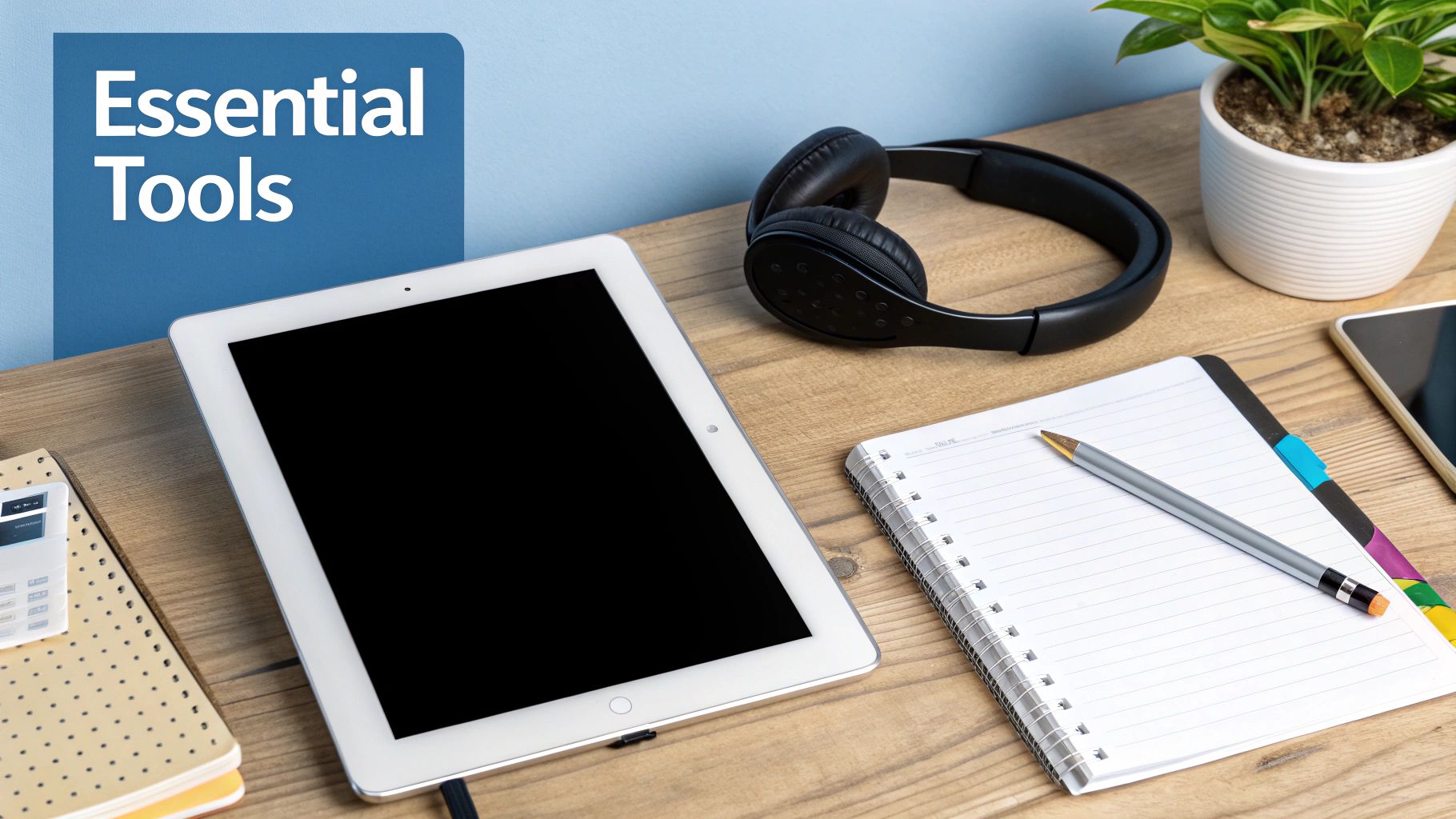
Success in an online GCSE Physics course goes far beyond the main curriculum. It’s about building a supportive learning ecosystem around your child, a digital toolkit that brings the subject to life and turns tricky revision sessions into genuinely productive experiences.
When a student feels equipped with the right resources, they take charge of their learning. They can plug knowledge gaps, hammer home difficult concepts, and practise exam techniques in a way that feels intuitive and modern. It’s about giving them the aids they need to build a deep, lasting grasp of physics.
Building A Digital Toolkit For Success
The beauty of online learning is the sheer wealth of resources at your fingertips. From interactive simulations to vast video libraries, you can put together a collection of tools that cater specifically to your child's learning style. The key is to find trusted, high-quality platforms that actually add value.
Here are a few types of resources that can make a real difference:
- Interactive Simulations: These let your child experiment with concepts like electrical circuits or wave interference in a safe, virtual space. It's hands-on learning without the need for a physical lab.
- Video Libraries: Sometimes, all it takes for a concept to click is hearing it explained from a different perspective. Platforms with extensive video tutorials can be a lifesaver for those head-scratching topics.
- Gamified Learning Apps: Who says memorising formulas has to be a chore? Some apps turn revision into a game, using points and leaderboards to motivate students and make learning feel less like a grind.
This kind of clear, well-organised dashboard—like the one from Study Mind shown below—is a key feature of a good learning platform. It helps your child see their progress at a glance, find specific topics easily, and stay organised.

The most powerful resources are those that give your child a sense of control over their learning. When they can choose how to revise, they become more invested in the outcome.
Curated Platforms And Trusted Aids
Finding the right support for your child is crucial. Online platforms for GCSE Physics have become incredibly popular across the UK, offering a rich variety of digital resources to suit different learning styles. Some providers, for instance, offer thousands of video tutorials covering the entire specification, bundled with revision notes and past paper collections.
Others go even further, providing thousands of digital flashcards to help with active recall. This all-in-one approach doesn't just help students understand tricky ideas; it gives them everything they need to apply that knowledge effectively in exams. By offering a structured learning space and access to expert tutors, these platforms have become a vital support for countless students. You can explore how some GCSE physics online courses are structured to see these features in action.
Ultimately, by curating a small collection of high-quality tools, you're doing more than just helping your child revise for an exam. You’re giving them the resources to build confidence, independence, and a genuine curiosity for the world around them.
Your Child’s Bright Future in Physics
Watching your child navigate their education can feel like a huge responsibility. Choosing an online GCSE Physics course is more than just a practical decision; it’s a loving one, designed to give them an environment where their unique spark can truly ignite, far from the pressures of a traditional classroom.
It’s about putting your child’s needs, confidence, and curiosity at the very centre of their education. The journey we've explored—from the flexibility of pausing lessons to the confidence built through one-on-one support—shows that this is a path designed for their success. You are giving them the gift of time, space, and control over their own learning.
Unlocking Their Potential
This choice empowers them in ways that will last a lifetime. The benefits aren't just academic talking points; they become deeply personal victories for your child:
- Flexibility and Personal Pacing: They can finally master difficult topics without the fear of being left behind or the frustration of waiting for others to catch up.
- Renewed Confidence: Each small win, whether it's solving a tough problem on their own or explaining a concept back to their tutor, builds them up, piece by piece.
- A Love for Learning: When education adapts to them, rather than the other way around, curiosity doesn't just survive—it flourishes.
You are not just enrolling them in a course; you are opening a door to their potential. This is a proactive step towards a future where they feel capable, confident, and genuinely excited by science.
Embracing this model is a step towards harnessing the true benefit of technology in education, which can profoundly improve your child's learning experience and their future prospects in STEM fields. You are giving them the best possible start on their journey into a bright, exciting future.
Any Questions About Online GCSE Physics?
Taking the leap into an online GCSE Physics course is a big decision, and it’s only natural to have questions. You want to be absolutely sure you're making the right choice for your child, and that means getting to grips with the details. We've put together the most common queries we hear from parents just like you to give you clear, straightforward answers.
Our goal is to help you feel confident and ready for this exciting new chapter. We’ll walk you through everything from how practicals are handled to booking the final exams, giving you a clear roadmap from start to finish.
How Do Practical Experiments Work Online?
This is usually the first thing parents ask, and for good reason. Physics is a hands-on subject, so how can a child possibly learn it without a physical lab? The answer is a smart blend of virtual and real-world experience that puts your child's understanding first.
Most top-tier online courses use sophisticated virtual labs and interactive simulations. Think about it: instead of risking a real-life short circuit, your child can build complex electrical circuits online, safely tweaking voltages and resistances with a simple click. They get to see the immediate consequences of their actions in a completely safe environment, which frees them up to experiment, make mistakes, and truly understand the concepts without any danger.
Of course, the GCSE requirements still include assessed practicals. These are completed during mandatory in-person sessions at designated centres, often packed into just a few days. This hybrid model really does offer the best of both worlds: endless virtual practice at home and focused, hands-on lab time to meet the official exam board standards.
What Kind of Tutor Support Can My Child Expect?
One of the biggest worries about online learning is the thought of your child feeling isolated or left behind without a teacher right there in the room. In reality, the support structure in a quality online school is often more personal than in a traditional classroom.
Instead of trying to get a teacher's attention in a class of 30 pupils, your child has a direct line to their subject-specialist tutors. This support isn't just an afterthought; it’s woven into the whole experience. It typically includes:
- Live Interactive Classes: These are small group sessions where students can ask questions in real-time and get into proper discussions, just like in a physical classroom but with far more individual focus.
- One-to-One Messaging: If your child is stuck on a wave speed calculation at 9 PM, they don’t have to wait until the next day. They can pop a direct message to their tutor and get a detailed, personal reply to help them move forward.
- Detailed, Constructive Feedback: Tutors provide in-depth feedback on assignments that goes beyond just marking things right or wrong. They explain why an answer was incorrect and guide your child on exactly how to improve next time.
This constant, direct line of communication ensures no child gets left behind. It turns learning into a genuine partnership, where your child feels seen and supported every single step of the way.
This level of tailored support builds a strong, trusting relationship between the student and tutor—something that is absolutely vital for boosting academic confidence.
How Do We Book The Final GCSE Exams?
Navigating the exam process as a private candidate might seem a bit daunting at first, but it’s actually a very straightforward process once you know the steps. Because your child is learning from home, you’ll need to register them at an approved exam centre that accepts private candidates.
Here’s a simple guide to get you started:
- Know Your Exam Board: Your online school will tell you which exam board they follow (e.g., AQA, Edexcel). This is the most important piece of information you need.
- Find a Local Exam Centre: The Joint Council for Qualifications (JCQ) website has a search tool to find approved centres near you. Your school will often have a list of partner centres they can recommend, too.
- Contact Centres Early: This is key. Start reaching out to potential centres well in advance, ideally in the autumn before the summer exams. You’ll need to ask if they accept private candidates for your specific subject and exam board.
- Register and Pay: The centre will then walk you through their registration process and let you know the fees. Once that’s done, your child is officially entered for the exam.
By planning ahead, you can make sure the final step of your child’s online GCSE Physics journey is smooth and free from stress, letting them focus completely on acing their exams.
Ready to give your child the focused, flexible, and supportive learning environment they deserve? Discover how the Queen's Online School can unlock their potential and reignite their passion for science. Explore our courses today at https://queensonlineschool.com.

